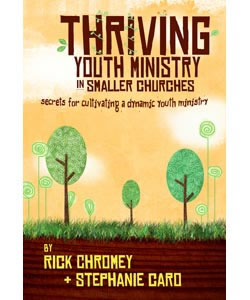In Thriving Youth Ministry in Smaller Congregations, Rick Chromey up-dates his previous book Youth Ministry in Smaller Churches (first published by Group in 1990 and most recently rereleased in 2009). This time around, Chromey adds the voice of Stephanie Caro, author of the “Smaller Church Youth Ministry” column for Group Magazine. This combination connects Chromey’s years of experience as a youth pastor, professor, leadership trainer and consultant with Caro’s current work in small church youth ministry. The result is a well-crafted book written for the vast majority of congregations who find the mega church models of youth ministry hopelessly out of reach and out of touch with their own efforts to guide the faith formation of the handful of teenagers who call their churches home.
Chromey’s theological foundation argues that, “The original DNA of the body of Christ is radically wired for relationship, redemption, and restoration. It’s about connection and community.” (p. 27). The early church stories of Ananias and Sapphira as well as Eutychus are cited as examples though no real details are provided to explain how specifically they affirm this claim related to the church’s DNA. I agree that we are wired for relationship; God’s creation of Eve and His rationale that “it is not good that the man should be alone” (Genesis 2:18) points to that. I would, however, challenge the assertion that we are wired for redemption and restoration. We are in need of both, but the imprint of original sin upon our nature pushes us to resist or reject rather than seek the free gift of grace by which Christ offers us redemption and restoration (Romans 7).
The unique structure of the book has Caro interacting with Chromey as though you are sitting in on a reading group and you are getting some reflections on the text by Caro. This helps to provide an additional viewpoint that at times shines the light on what Chromey is trying to convey with just the right differing perspective. Chromey makes the argument that the future of youth ministry is small rather than large. For many this is not an argument that needs all that much corroboration. Working with the congregations in the Pacific Southwest District, I see firsthand how the vast number of youth groups are at best a dozen or smaller. Caro provides a voice from the trenches that pastors, DCE’s and volunteer youth leaders will find reflects some of their own concerns and struggles.
One of the great points that Chromey makes comes as he pushes back on the concept that success in youth ministry is all about larger numbers. He argues that we can and should embrace the reality of the size of congregation and thus youth ministry we are called to serve and seek to grow tall not by numerical growth, but through ever deepening spiritual growth through relational ministry.
Having served in both small and medium sized congregations and having begun working with many congregations of varying sizes, this challenge to grow tall is one that I would suggest should be sought regardless of size. Ironically the smaller church stands the best chance of developing the relational depth in which to cultivate dynamic youth ministry. Rather than allow a lack of numbers cause you to undervalue the ministry impact and potential of the small church youth ministry, Chromey rightly urges leaders to embrace the micro or the mini in ministry.
Chromey observes a connection between the emergence of “microtrends” in our culture and youth ministry. The days of mass production have come and gone. Though we all desire great numbers of the lost to be drawn into a saving faith in Christ, the belief that this is best done in large ministry contexts is rightly being challenged. As people seek greater depth in their walk with Christ, there is a tendency to move from the mega to the micro. There have even been situations in which a great number of smaller churches, focusing on developing greater depth, are found in rings around mega churches as believers move from a place the emphasizes seekers to ones that emphasize discipleship of those already a part of the church.
The kingdom of God is in need of both approaches to ministry, both from a congregational and a youth ministry perspective. What is especially needed, that Thriving Youth Ministry in Smaller Churches provides, is a voice of experience to speak to the small and tall rather than the typical “successful” mega church youth pastor turned Youth Specialties seminar guru. We certainly can and should learn from both, but what Chromey offers is a lens that the vast majority of churches need to see in their efforts to reach their teens through dynamic small church youth ministry.













0 Comments